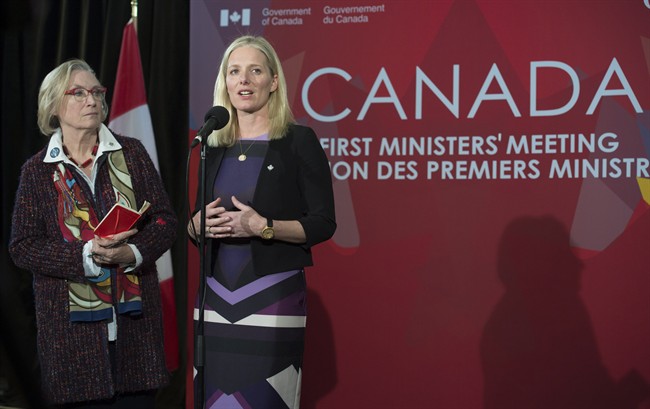What the pan-Canadian climate plan gets right
The agreement between Ottawa and all but two of the provinces is the result of negotiation and compromise—though two red flags remain

Environment Minister Catherine McKenna answers a question during Question Period in the House of Commons in Ottawa, Wednesday, April 20, 2016. (Adrian Wyld/CP)
Share

Climate policy is difficult. Effective negotiations between various governments might be even harder. So, kudos to Canada’s first ministers for making real progress on a seriously difficult issue. As of last Friday, we formally have a pan-Canadian framework on climate policy. Even better, the plan actually comes pretty close to matching the ambition of our current targets.
That formal framework—as is often the case in Canada—is the result of lots of negotiation and compromise. The plan walks a line between textbook “efficiency” and real-world “practicality.” Efficiency is essentially about minimizing the economic costs of reducing GHG emissions. These costs matter a lot—especially in a world of slow economic growth in which average living standards are barely rising. Practicality is well known to all successful politicians, as it is about building consensus. Such broad-based acceptance is essential if the policy is to endure the ebbs and flows of the political tides.
Overall, the compromise embedded within the pan-Canadian agreement appears to be worthy of the considerable efforts required to achieve it. Yet some tough questions remain, and careful implementation will be critical.
Let’s take a look at three key elements of the framework.
First, it affirms a rising carbon price across Canada. This is the biggest win for low-cost climate policy. Economists are virtually unanimous that broad-based carbon pricing is the lowest-cost way to reduce GHG emissions. A carbon price doesn’t pick specific technologies or sectors for emissions reductions. It lets emitters identify their own methods of reducing emissions—and they have a powerful incentive to find the lowest-cost approach.
MORE: Why carbon pricing is smarter than setting emissions targets
Second, the plan ensures that provinces and territories can keep the carbon revenues and recycle them as they see fit. Smart revenue recycling can generate real economic benefits, thus lowering the overall costs of the policy. There is no single “best” way, but each province and territory is free to choose its own approach. Whatever their respective choices, the plan ensures that revenues will not be taken from one province and given to others.
Third, the plan gives provinces flexibility in how they price carbon. Some provinces—such as Ontario and Quebec—have cap-and-trade systems. Others—such as British Columbia and Alberta—have carbon taxes. This flexibility is key to building pan-Canadian support for the framework, largely because it accommodates existing provincial policies.
These three elements reveal a combination of policy efficiency and practicality. The focus on carbon pricing ensures low costs; the provincial flexibility demonstrates great practicality. So far, so good.
Two red flags are nonetheless worth recognizing.
One downside with so much provincial flexibility is that we may end up with quite different carbon prices across the country, especially if Quebec and Ontario continue to have access to low-price emissions permits from California. The potential problem is that large price gaps may lead businesses to relocate their activities, playing a zero-sum game across the country. One solution is to require all provinces to allow the trade in offsets or emissions permits from outside the province; such trade would tend to align the various carbon prices. But the announced framework is silent on this possibility.
A second potential problem relates to the country’s long-term carbon price. If the minimum carbon price does not continue to rise beyond $50 per tonne in 2022, the framework risks either driving insufficient emissions reductions or relying too much on non-price (and thus high-cost) climate policies to do the lion’s share of the work. There is certainly a role for some “complementary” policies, but governments should design these carefully. They should reinforce the carbon price, filling in gaps and making it work better, rather than doing the heavy lifting. Inflexible regulations and technology-specific subsidies can significantly increase overall policy costs.
One final piece of the framework can play an important part in addressing these problems. Formal reviews in 2020 and 2022 will be opportunities to revisit provincial carbon-pricing policies. Are differences in carbon prices becoming a problem? If so, what mechanisms should be used to align the prices? At what rate should the minimum carbon price increase? Adjusting policy over time can improve performance, and a scheduled review is a practical process for doing so.
All in all, the new pan-Canadian climate framework is quite an achievement. It is an impressive—and very Canadian—combination of efficiency and practicality.
Christopher Ragan is an associate professor of economics at McGill University and is the Chair of Canada’s Ecofiscal Commission.